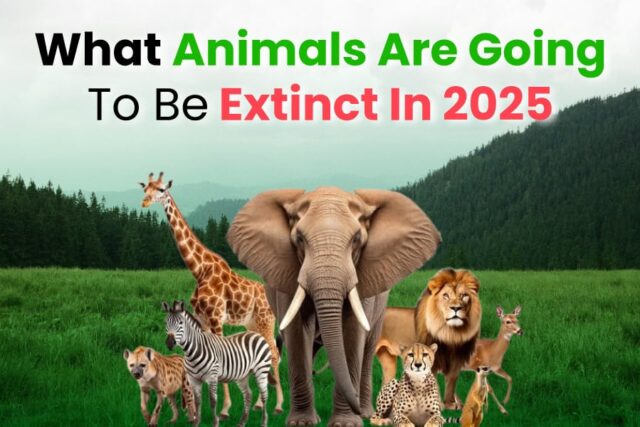If you consider the way animals are being killed and trafficked, it’s obvious that many will become extinct soon. So, what animals are going to be extinct in 2025?
Animals are dying in their numbers every day, thanks to illegal hunting, climate change, and others. Tons of species have been wiped off the planet. So, many animals could become extinct in a few years from now.
The IUCN Red List hints that over 900 species have become extinct since 1500. But it can get worse if we fail to act fast.
Here, we’ll discuss the names of animals that report claims could exit our planet finally in 2025. We need to act fast to prevent it from happening. Check out their names.
1: Koalas (endangered):
Koalas are the last group of animals anyone would dream of seeing on the list of animals that could become extinct by 2025. These adorable creatures are harmless, cute, intelligent, fun, and hardworking.
Unfortunately, koalas will cease to exist if we don’t act decisively. They are one of the animals predicted to become extinct in 2025.
Where do Koalas come from? These creatures are endemic to Australia and can mostly be found in the southeast, including the eastern part of the country.
They live along the coastlines of New South Wales, Victoria, Queensland, and South Australia.
Here are the factors responsible for the extinction of koalas.
- Disease leading to death
- Drought made worse by climate change
- Land clearing leading to loss of habitat
- Dog attacks on koalas lead to death or life-threatening injuries
- Bush fires lead to the loss of koalas’ natural habitat and death.
All these factors are preventable. For instance, we can identify and treat sick koalas before their conditions worsen. Proper monitoring of koalas will help prevent casualties from sicknesses.
To prevent extinction, preserving koalas’ natural habitat is also essential in any program. They should be adequate food for the creatures, too. The planting of koala corridors can help save the endangered species.
These are some of the factors responsible for the reduction in the koala population. We must stop destroying their homes if we’re serious about preventing the extinction of these creatures.
Here’s a summary of how we can stop koalas from going into extinction:
- Stop clearing the habitat of koalas
- Climate pollution has to stop
- The government should create strong environmental laws
If we take these steps, we will have a good chance of saving koalas from extinction.
A Handy Tip: On February 12, 2022, koalas were tagged endangered under the EPBC Act.
2: African Forest Elephant (endangered):
The IUCN listed the African forest elephant as an endangered species in 2021. Unfortunately, the factors contributing to a reduction in their population haven’t changed significantly.
The African forest elephant is lesser known in the region. It hides deep within the jungle. They are one of the species in the area in urgent need of protection.
Illegal hunting of these creatures is decreasing their population. The report shows around 96 elephants per day, or 35,040 per year, are being killed by illegal hunters. They kill them and harvest their ivory.
The world needs to take drastic steps to discourage poachers from killing these endangered species. It is not a fight for Africans alone. The world needs to join hands to fight illegal poaching and eradicate other factors contributing to the extinction threat the African forest elephants are facing.
In 1989, there was an international convention regarding the sale and use of ivory. In that convention, the ivory trade was abolished. The idea was to discourage poachers from killing the African forest elephants and other endangered species.
The ban worked for a while, as it discouraged poachers. The market for ivory drastically reduced. Unfortunately, it didn’t take long before the appetite of people involved in the ivory trade increased. The demand for ivory returned, and that encouraged poachers to start their illegal hunting activities.
Illegal hunting isn’t the only factor threatening the existence of the African forest elephant. Here are other factors:
Habitat loss and fragmentation, African elephants now have less room to roam than before. The expanding human population is encouraging the conversion of lands for agriculture, settlement, and development.
Human-elephant conflict is another factor contributing to African elephants’ extinction threat. As the human population expands, people encroach into the habitat of these creatures. The contraction of their habitat means humans and elephants will encounter themselves occasionally, which may lead to serious confrontation.
3: Rhinoceros (critically endangered):
Several countries in the African region, including Asia, no longer have rhinos. They have lost their rhinos forever. They failed to take drastic action to address the illegal hunting and trade, encouraging the killing of rhinos in their regions. They were unable to keep their rhinos safe.
Eleven rhino species were available, but six have disappeared, leaving only five behind. These are the White rhino, Javan rhino, Sumatran rhino, Indian Rhino, and Black rhino.
The five rhinos remaining are facing threats. Of the five, three rhinos have been named “critically endangered.” These are the Sumatran rhino, Javan rhino, and Black rhino.
How many rhinos are in existence?
The population of rhinos has reduced drastically, especially the Javan rhinos. There were 66 Javan rhinos, but only 44 are remaining. They live in Indonesia’s Ujung Kulon National Park.
The Javan rhino will go into extinction if we don’t act fast. The demand for rhino horns keeps encouraging poachers to hunt them illegally. Rhino’s use in Chinese medicine has been widespread for centuries. The medicinal usage and illegal hunting of rhinos are threatening their existence.
What happened to the last Sumatran rhino in Malaysia? It died in 2019.
How many Sumatran rhinos are left in Indonesia? The Sumatran rhino population in Indonesia has reduced massively over the years. Today, less than 80 Sumatran rhinos exist, 20 in captivity.
What significant threats are the Sumatran rhinos facing? The two major threats are reproduction and poaching. While poaching is a resolvable issue, the reproductive issue is a considerable challenge.
The last male Sumatran rhino has died. So, the remaining Sumatran rhinos are all female. Thus, it’s only a matter of time before the entire Sumatran rhino population becomes extinct, as reproduction is no longer possible without a male rhino.
What is happening to Black rhinos? Of the five rhinos, the Black rhino is the third largest. Like the Sumatran, the Black rhino faces extinction if nothing is done. Since 1960, around 97.6 percent of these creatures have been killed.
Poachers keep killing these animals for their horns. And as long as there is a market for such items, the illegal hunting will not end.
4: Panda (endangered):
Pandas are endemic to China. It has around 1800 pandas, 20 of which have been donated to other countries. If you find pandas in any country besides China, they probably got it from China.
The population of pandas in China has increased impressively in recent years after the Chinese government took drastic steps to address the problems responsible for their extinction threats.
Before the government’s intervention, pandas were on the endangered species list. Only less than 1,140 were in the wild.
What are the factors responsible for the panda’s extinction prediction? The first factor is the loss of natural habitat. Pandas have a higher chance of surviving when left in their natural habitat. Unfortunately, population expansion forces people to invade pandas’ natural habitat, including other wildlife.
In addition to habitat destruction, poaching is another factor threatening the extinction of pandas. People hunt pandas illegally for selfish reasons.
Climate change is also making life difficult for pandas. It is responsible for the massive loss of panda food, such as bamboo.
Pandas consume a lot of bamboo daily. They eat around 25-50 pounds of bamboo. And the reason they consume this much is to get the necessary energy for mobility and procreation. Unfortunately, even the bamboo growing in the wild these days lacks appropriate nutrients. Consuming bamboo that isn’t nutritious enough hurts pandas.
The hot climate is killing the bamboo in the wild. It has wiped off around 99% of the panda food.
What can be done to prevent pandas from going extinct?
The Chinese government has been taking giant steps to ensure pandas don’t go extinct, which is paying off. Pandas have moved from the endangered to the “vulnerable” list as their population has increased in recent years.
There are currently over 1800 pandas in the wild, indicating the excellent work the Chinese government is doing.
5: Sloth:
Who would have thought sloths would be at risk of extinction? They are so innocent-looking, soft, and adorable. But then, in the wild, looks don’t count. Human activities, including poaching, have put the lives of several animals, like sloths, in great danger.
Six sloth subspecies are native to two regions, Central America and South America. Unfortunately, all six species are in danger of extinction. They face several extinction threats caused by illegal trafficking, deforestation, and habitat loss.
The pygmy three-toed sloth faces the most extinction threat of all six species. It is on the critically endangered list.
On the other hand, the manned three-toed sloth is on the “vulnerable” list. But as we all know, the condition can change very fast. If factors responsible for the death of sloths aren’t controlled, the manned three-toed may join the critically endangered list.
Most sloths trafficked from the wild don’t reach their traffickers’ destinations. Most of them die on the way. The group responsible for protecting sloths in Columbia and Central America claims that around 80-90% of sloths that are trafficked die in transit.
Unlike most animals, sloths can’t handle stress. They are susceptible and can easily crumble when subjected to high stress, which traffickers are famous for.
The respiratory and digestive systems collapse when these animals pass through extreme stress. And that can lead to death.
Many traffickers hunt for baby slots and don’t even handle them with care. They violently separate them from their mother and keep them in a crowded environment.
Meeting sloth’s nutritional needs is a challenge for most traffickers looking to make easy money. And when they fail to meet the dietary needs of the baby sloths, the animals become malnourished. It could also die in the process.
Why sloth trafficking should be stopped.
Trafficking animals is never a good thing. No animal deserves to undergo such a treatment.
Traffickers lack the skills and knowledge required to rear or keep sloths. Most don’t even know the animal’s nutritional requirements, let alone the environmental conditions to keep them.
Sloths do well in the wild. They source their food and find shelter. So, they should remain in their natural habitat. Separating sloths from their natural habitat can cause severe stress and shock that could lead to death.
The second mistake traffickers make is cutting off the nails of sloths. The reason is to prevent the animals from hurting them. Unfortunately, what these traffickers fail to realize is that cutting off the nails of sloths is synonymous with taking the animals’ ability to source food.
These animals feed on fruits and leaves. That’s why you’ll find them hanging on trees often. Cutting their nails means they’ll no longer have the ability to get the food and nutrition they need to survive.
A Handy Tip: People trafficking or buying sloths are the same. If there were no market for the creatures, there would be no trafficking. Most of the people buying sloths increase their offers from time to time to encourage illegal trafficking. They are encouraging the people killing the adult sloths and separating the babies from their mothers to do more.
If you’re a tourist, stop disturbing the peace of sloths. Let the animals remain in their natural habitat. Most tourists pay to visit, feed, and come in close contact with sloths. But that shouldn’t be the case if we’re serious about keeping the animals safe.
Countries you can find sloths:
- South America
- Columbia
- Venezuela
- Brazil
- Peru
- Costa Rica
- Honduras
- Bolivia
- Ecuador
- Central America
6: Porpoises (critically endangered):
Porpoises are another group of animals that may become extinct unless we act fast. However, not all species of this creature are facing an extinction threat.
There are seven porpoise species in the world. Check them out below:
- Dall’s Porpoises
- Vaquita Porpoises
- Harbor Porpoises
- Burmeister Porpoises
- Spectacled Porpoises
- Narrow-ridged finless Porpoises
- Indo-Pacific finless Porpoises
Two subspecies of the narrow-ridged finless porpoises exist. They include the Yangtze and the famous East Asia finless porpoises.
The issue the finless porpoises have is their food requirement. They eat a lot. They need the right amount of food to help them survive in their natural habitat. Human activities are negatively impacting their food supply.
The Yangtze porpoises are in great danger. They are now on the “critically endangered” species list. These creatures face a series of threats that could wipe them off the planet. Their existence is being threatened by overfishing, pollution, and even ship movement.
7: Amur leopard:
The Amur leopard is another animal that needs saving. Otherwise, they may become extinct sooner than forecasted.
This forest-dwelling cat boasts an impressive adaptive ability. It dwells in the temperate forests. It is a native of the Amur-Heilong region.
Amur leopard boasts several names. It is often known as the Far East, Korean, or the Manchurian leopard.
This leopard is an adorable creature, quite solid and solitary.
The Amur leopards live for an extended period. They have a lifespan of 10-15 years in the wild. In captivity, they tend to live longer. They can live for more than 20 years with proper nutrition and care.
How many Amur leopards are in captivity and the wild?
In captivity, there are over 180 of them. But in the wild, there are fewer than 100 Amur leopards.
What threats do Amur leopards face?
The main threat this leopard faces is trafficking. People hunt them to harvest their adorable fur.
If the illegal hunting isn’t stopped, the Amur leopard could become extinct sooner than we think. The ones in the wild are facing severe threats of extinction.
Conclusion
What animals are going to be extinct in 2025? The list is growing by the day. The activities of illegal hunters have increased over the years as the market for trafficked animals and their products keeps growing. The world needs to take action. Otherwise, most of the species we cherish will be no more.
These illegal markets must end. Countries must take responsibility to stop the trafficking of animals, as it poses a huge threat to the existence of wildlife. There should also be stricter punishment for people caught trafficking wildlife, including those who purchase such products. If we can take these decisive steps, our wildlife population will be safe from extinction.














